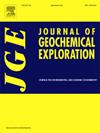Geochemistry and genesis of skarn-related tungsten mineralization of the Salau Deposit, Pyrenean Axial Zone
IF 3.3
2区 地球科学
Q1 GEOCHEMISTRY & GEOPHYSICS
引用次数: 0
Abstract
This study investigates the trace element chemistry of scheelite and sulfides (chalcopyrite, arsenopyrite, pyrrhotite) from the reduced skarn Salau deposit, one of France's largest tungsten deposits, located in the Pyrenean Axial Zone, to unravel the interplay between Variscan granodiorite intrusion, fluid composition and evolution, and metal transport during deposit formation. Cathodoluminescence imaging and geochemical data identify multiple scheelite generations corresponding to different mineralization stages: an early-stage, high-temperature type (GB Sch I) characterized by negative Eu anomalies, and a later retrograde type (GB Sch II) with positive Eu anomalies, both exhibiting internally variable but globally low Mo content characteristic of reduced skarn. A third, late-stage scheelite generation (GD), influenced by Veronique Fault-derived fluids, exhibits LREE depletion and near absent Mo concentrations (<2 ppm), forming in association with sulfide-rich mineralization (arsenopyrite: As <51 wt%, Bi <483 ppm; pyrrhotite: Co/Ni >5).
Laser ablation inductively coupled plasma mass spectrometry (LA-ICP-MS) analyses of scheelite and sulfides provide new insights into fluid evolution and trace element partitioning in the Salau skarn system. Scheelite displays distinct trace element variations, with early-stage crystals (GB Sch I) characterized by a relatively higher Mo (though <0.1 wt%) and negative Eu anomalies, while later scheelite generations (GB Sch II, GD) exhibit evolving REE patterns and elemental enrichments linked to fluid chemistry changes. Sulfides, including chalcopyrite, arsenopyrite, and pyrrhotite, show compositional differences that reflect variations in sulfur activity and metal transport mechanisms.
Trace element systematics (e.g., Sr2+, Mo6+, REEs) indicate a transition from high-temperature magmatic-hydrothermal fluids to lower-temperature, sulfur-rich hydrothermal phases. Under sustained reduced conditions, with Y/Ho correlations suggesting minimal fluid mixing. Geochemical signatures primarily reflect fluid evolution within this reduced skarn framework, recording progressive changes in temperature, salinity, and redox conditions.
比利牛斯山轴带萨劳矿床夕卡岩型钨矿化地球化学及成因
本文研究了位于比利牛斯山脉轴向带的法国最大的钨矿之一——夕卡岩Salau矿床中白钨矿和硫化物(黄铜矿、毒砂、磁黄铁矿)的微量元素化学特征,以揭示Variscan花岗闪长岩侵入、流体组成和演化以及矿床形成过程中金属运移之间的相互作用。阴极发光成像和地球化学资料鉴定出多代白钨矿,对应于不同的成矿阶段:早期高温型(GB Sch I),具有负Eu异常特征;晚期逆行型(GB Sch II),具有正Eu异常特征,均表现出内部可变但整体低Mo含量的还原夕卡岩特征。第三代是晚期白钨矿(GD),受Veronique断层衍生流体的影响,表现出低稀土元素(LREE)枯竭和接近不存在的Mo浓度(<2 ppm),与富硫化物矿化(毒砂:As <;51 wt%, Bi <483 ppm;磁黄铁矿:Co/Ni >;白钨矿和硫化物的激光烧蚀电感耦合等离子体质谱(LA-ICP-MS)分析为研究Salau矽卡岩体系的流体演化和微量元素分配提供了新的思路。白钨矿表现出明显的微量元素变化,早期晶体(GB Sch I)具有相对较高的Mo(尽管<;0.1 wt%)和负Eu异常,而后期白钨矿(GB Sch II, GD)表现出演化的REE模式和与流体化学变化相关的元素富集。硫化物,包括黄铜矿、毒砂和磁黄铁矿,其组成差异反映了硫活性和金属运输机制的变化。微量元素(如Sr2+、Mo6+、REEs)表明岩浆热液由高温热液向低温富硫热液相转变。在持续减少的条件下,Y/Ho相关性表明流体混合最小。地球化学特征主要反映了这个还原夕卡岩框架内的流体演化,记录了温度、盐度和氧化还原条件的渐进变化。
本文章由计算机程序翻译,如有差异,请以英文原文为准。
求助全文
约1分钟内获得全文
求助全文
来源期刊

Journal of Geochemical Exploration
地学-地球化学与地球物理
CiteScore
7.40
自引率
7.70%
发文量
148
审稿时长
8.1 months
期刊介绍:
Journal of Geochemical Exploration is mostly dedicated to publication of original studies in exploration and environmental geochemistry and related topics.
Contributions considered of prevalent interest for the journal include researches based on the application of innovative methods to:
define the genesis and the evolution of mineral deposits including transfer of elements in large-scale mineralized areas.
analyze complex systems at the boundaries between bio-geochemistry, metal transport and mineral accumulation.
evaluate effects of historical mining activities on the surface environment.
trace pollutant sources and define their fate and transport models in the near-surface and surface environments involving solid, fluid and aerial matrices.
assess and quantify natural and technogenic radioactivity in the environment.
determine geochemical anomalies and set baseline reference values using compositional data analysis, multivariate statistics and geo-spatial analysis.
assess the impacts of anthropogenic contamination on ecosystems and human health at local and regional scale to prioritize and classify risks through deterministic and stochastic approaches.
Papers dedicated to the presentation of newly developed methods in analytical geochemistry to be applied in the field or in laboratory are also within the topics of interest for the journal.
 求助内容:
求助内容: 应助结果提醒方式:
应助结果提醒方式:


